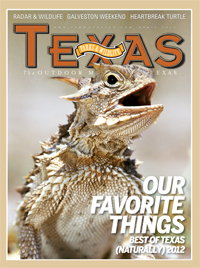
The Saga of the Heartbreak Turtle
A documentary sequel outlines 30 years of Kemp’s ridley sea turtle restoration.
By Matthew Abernathy
The term arribada, the Spanish word for arrival, was used in 1947 to describe the approximately 40,000 Kemp’s ridley sea turtles observed nesting in one day on a beach near Rancho Nuevo, Mexico. Forty years later, fewer than 600 turtles nested along that same stretch of beach during the entire season.
Kemp’s ridleys became known as the “heartbreak” turtle because, when caught and put on its back on a boat deck, the turtle would thrash to the point of death, causing fishermen to believe it died of a broken heart.
Unregulated fishing and collection of both turtles and their eggs contributed to the species’ decline. Now, thanks to conservation efforts over the past 25 years, the Kemp’s ridley population is starting to recover.
Much of that recovery, especially along the Texas coast, is due to the efforts of Carole Allen, whose passion for these turtles goes back 30 years to when she founded HEART (Help Endangered Animals — Ridley Turtles) in 1982.
With the help of schoolchildren around the country who participated in a letter-writing campaign, she worked to extend funding for a “head start” program for Kemp’s ridley turtles in Galveston, in which turtles are reared in captivity and then released in the wild. Allen continued to work as an advocate for the turtles, and in 2002 became the Gulf director of the Sea Turtle Restoration Project, a worldwide organization dedicated to sea turtle conservation. She has been integral in getting legislation passed requiring shrimp trawlers to use turtle excluder devices (TEDs).
What fuels her passion for Kemp’s ridley recovery? “The preservation and recovery of the Kemp’s ridley sea turtles is extremely important because it is an example of what can be done when countries and agencies work together,” Allen says. “The activities of human beings, from stealing eggs and killing turtles for leather in Mexico to drowning thousands of sea turtles in shrimp trawls in U.S. waters, caused the near extinction of the Kemp’s ridleys.” Allen works to change those destructive behaviors.
One step in Allen’s efforts toward the recovery is a documentary focusing on the Kemp’s ridley. The Heartbreak Turtle Today highlights the progress the Kemp’s ridley has made in recent years, but also emphasizes concerns that still need to be addressed. The film was shown on PBS stations nationwide last year.
More than 30 years ago, the original Heartbreak Turtle documentary was produced by the University of Houston’s PBS station to help educate the public on the issues surrounding the Kemp’s ridley sea turtle. Now, this sequel to the original documentary (with footage of the amazing 1947 arribada) demonstrates that it was possible to bring this species back from the brink of extinction. Through the efforts of Allen and others, there are now many nesting sites along the Texas coast, with hopes that the number will continue to grow. The story told by biologists, academics, government employees and others in this documentary shows the hard work that has been accomplished to help this species, and how much work still lies ahead. The Deepwater Horizon oil spill occurred in the Gulf during production of the film, and the long-term effects of that spill are still being calculated.
Allen hopes the documentary will be a tool to help educate others about Kemp’s ridleys and the ways we can ensure a long future for this species in the Gulf of Mexico.
To get a copy of The Heartbreak Turtle Today, and for more information regarding Kemp’s ridley conservation programs along the Gulf of Mexico, contact Allen at 281-444-6204 or carole@seaturtles.org. For more information about sea turtles and sea turtle conservation efforts, please visit www.seaturtles.org.

